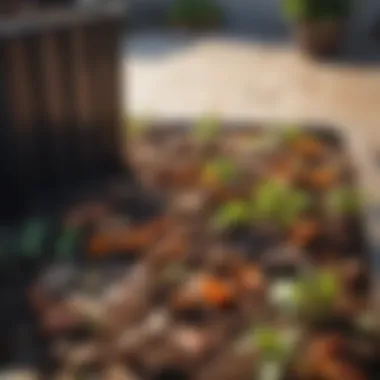Apartment Patio Composting for Sustainable Living


Intro
Apartment living often conjures images of high-rises and bustling city life, where green space feels like a distant dream. Yet, with a sprinkle of creativity and a dash of commitment, even the smallest patio can become a thriving spot for composting. This guide delves into the nitty-gritty of apartment patio composting, offering practical advice aimed at urban dwellers eager to embrace sustainability.
In the face of increasing urbanization and environmental concerns, composting stands out as an easy yet impactful way to reduce waste and enrich the soil. Imagine transforming your kitchen scraps and yard waste into nutrient-rich compost right from the comfort of your balcony. It's not just eco-friendly; it's a chance to connect with nature amidst concrete. Throughout this guide, we'll explore the many facets of composting that can be adapted for life in an apartment. From the why's and how's of composting to the essential materials needed for a successful setup, readers will gain insights into fostering a greener environment, no matter the limited space.
Let's dive deep into the various methods for making the most of your apartment patio, tackling each aspect with care and expertise, so you can kickstart your composting journey and contribute to a more sustainable urban lifestyle.
Preamble to Apartment Patio Composting
In the hustle and bustle of city dwellings, where square footage is often at a premium, the idea of turning a small patio into a compost station might sound a bit far-fetched. Yet, apartment patio composting serves as a practical solution for many urban residents yearning for a touch of nature and a sustainable lifestyle. This section does not just introduce the concept; it lays the groundwork for understanding why composting is essential, even when one's outdoor space is limited.
Understanding Composting
Composting is not merely a hobby for the green-thumbs; it’s a dynamic process of recycling organic material. Food scraps, leaves, and yard waste break down into a nutrient-rich soil amendment that can significantly enrich plant life. There’s a beautiful cycle within composting that mirrors nature’s way of recycling nutrients. When discussing composting, it’s crucial to grasp the delicate balance of 'greens'—high in nitrogen, like vegetable peels—and 'browns'—rich in carbon, such as dry leaves and cardboard. Together, these materials turn into the earthy, aromatic compost that, quite frankly, is the lifeblood of any garden, patio, or balcony.
The act of composting taps into a deeper understanding of waste management. Rather than mindlessly tossing scraps into the trash, composting encourages a mindset shift towards stewardship of resources that fosters long-term sustainability.
The Importance of Composting in Urban Settings
Cities are often characterized by concrete jungles and sprawling buildings, but this doesn't mean they need to be devoid of life. Apartment patios provide a unique opportunity for city dwellers to participate in the larger movement of sustainability.
- Reduction of Waste: Urban areas struggle with waste disposal. Composting at home helps divert organic matter from landfills, which, in turn, reduces the amount of methane produced—an alarming greenhouse gas. A small effort from each individual can lead to significant cumulative effects.
- Enhancing Local Ecosystems: Integrating composting into apartment living encourages biodiversity. Even the smallest balcony can host a variety of plants that attract beneficial insects, pollinators, and promote a healthier urban environment.
- Community Engagement: Composting isn’t just a solitary endeavor; it creates opportunities to engage with neighbors. Sharing tips, materials, or even finished compost can foster a sense of community that extends beyond one's patio.
Effective composting can turn urbanism’s challenges into opportunities. When practiced consistently, it not just improves the physical environment but enriches a community's fabric.
"Taking the plunge into composting in urban settings can be the connective thread that ties together eco-conscious residents, shaping a greener tomorrow one patio at a time."
As we move forward through this guide, the sections that follow will explore the myriad benefits of apartment patio composting and the various methods by which one can embark on this rewarding journey.
Benefits of Composting on Apartment Patios
Composting on apartment patios presents a unique opportunity to marry sustainability with urban living. In the hustle and bustle of urban environments, many residents often overlook how small spaces can make a real difference. Composting, especially in a confined area like a patio, not only meets practical needs but also fulfills a deeper desire for environmental stewardship. Let’s dive into the various advantages that this practice brings to our modern lives.
Environmental Benefits
Starting with the environment, the benefits of composting are profound. It reduces waste significantly. Kitchen scraps that might otherwise end up in landfills can be transformed into nutrient-rich compost. Gases emitted from decomposing waste in landfills, particularly methane, contribute to climate change. By composting at home, we can lessen our carbon footprint.
- Composting enriches soil, enhancing its ability to retain moisture and nutrients. This leads to healthier plants, ultimately promoting biodiversity.
- It helps prevent soil erosion, a common issue in urban settings where greenery is lacking. Healthy, compost-amended soil holds together better and absorbs water effectively.
- With a shift toward organic composting materials, we indirectly reduce reliance on chemical fertilizers. These chemicals can leach into waterways, causing pollution.
Composting on patios is not just about the active process, it’s about building a culture of sustainability and creating green habits that can ripple out into the community.
Economic Benefits
Now, let’s talk dollars and cents. Composting offers substantial economic benefits. Many urban dwellers may be surprised to find that composting can indeed lighten your wallet.
- First, using homemade compost cuts down on the need to purchase fertilizers or soil amendments. Over time, that adds up. Just imagine the savings on your gardening budget!
- Additionally, those who compost tend to see healthier plants and produce, which can lead to higher yields if you're growing veggies or herbs. More homegrown food means fewer trips to the grocery store, further saving money.
- On a broader scale, cities often spend a fortune managing organic waste in landfills. When residents take the initiative to compost, it can ease some of that financial burden. A collective shift toward composting might just lead to lower waste management fees for municipalities—imagine the impact!
Social Benefits
Moving on to the social aspect, composting isn’t merely a solo endeavor; it fosters a sense of community. A shared interest in sustainability can bring neighbors together, creating bonds and encouraging cooperation.
- Participating in composting can lead to educational opportunities. Neighbors can swap tips, tricks, and lessons learned. This sharing of knowledge nurtures community growth.
- Composting can spark discussions about broader environmental issues, empowering individuals to advocate for greener policies in their regions.
- Not to forget, a vibrant garden fueled by compost can enhance the appearance of shared spaces, boosting neighborhood pride. People tend to take better care of spaces that contribute positively to their surroundings.
In summary, the benefits of composting on apartment patios extend well beyond personal gain. It is a path toward environmental health, economic savings, and social cohesion. As we cultivate our little patches of earth, we’re also digging our way toward a more sustainable future.
Choosing the Right Composting Method
The method you select for composting on your apartment patio can make or break your experience. With limited space, convenience, and effectiveness in mind, the right approach not only enhances your composting success but also makes the process more enjoyable. When urban dwellers choose their composting method, they should consider their lifestyle, the materials available, and the space they can dedicate to composting. Each method offers distinct advantages and might cater to specific needs or preferences.


Traditional Compost Piles
Traditional compost piles, while often met with enthusiasm by seasoned gardeners, can be a bit of a challenge for those pressed for space. They call for a larger area and need regular turning to aerate the mixture, which could be elusive in an apartment setting. However, if you have a suitable area on your patio and the commitment to maintain things, this method can yield rich compost.
- Pros: Suitable for a variety of organic materials, including kitchen scraps and yard waste. The final product is usually robust and nutrient-dense.
- Cons: Space-consuming and may attract pests if not managed properly. Requires balancing greens and browns meticulously.
Bokashi Composting
Bokashi composting is a game changer for city dwellers. Originating from Japan, this method utilizes a fermentation process which makes it a great option for those wanting to compost meat and dairy. The hiccup is that it's not traditional composting, meaning it won’t smell like fresh grass and soil. Instead, it ferments organic materials in a sealed container, breaking down waste quicker.
- Pros: Minimal odor and can handle a wider range of food scraps. Compact and perfect for small patios.
- Cons: The need to purchase Bokashi bran can be a downside. Requires subsequent burying of the compost for full breakdown.
Vermicomposting
Vermicomposting involves using worms to decompose organic waste – sounds a bit odd, right? Yet, it’s a remarkable method for apartment dwellers. Bin systems can fit easily under sinks or on balconies while providing an ongoing source of nutrient-rich castings to bolster your plants. This method is not just space-efficient but also a hands-off approach once the system is established.
- Pros: Highly efficient at breaking down kitchen scraps. Produces material that is excellent for houseplants or container gardens.
- Cons: Requires knowledge about worm care and management. If you forget about feeding them or overfeed, it can turn into a bit of a mess.
Composting Bins and Tumblers
If you’re short on space and time but want to make composting part of your sustainable lifestyle, consider composting bins and tumblers. These products come in various sizes and can fit neatly on your patio without taking up too much room. They usually come with an easy-to-access feature for turning or mixing your compost, making the whole process straightforward.
- Pros: Compact and enclosed design. Can come with features like a crank or tumbling system for easier mixing.
- Cons: May be more costly than simply creating a pile. Some models can be cumbersome if not designed well.
In short, the method of composting that suits you best will largely depend on your personal circumstances. By evaluating your space, material availability, and tolerance for maintenance, you can find a composting method that fits seamlessly into your urban lifestyle. Don’t forget to consider how much effort you want to put in; because, let's face it, we'd all prefer a little ease in our daily hustle.
"Choosing the right composting method is like picking the right tool for the job; it can make all the difference in the outcome."
As you ponder over these options, it’s essential to weigh the benefits against the limitations. Balancing your desire to positively impact the environment with your practical needs will lead you to quick decisions. Select wisely, and you'll find composting can be a rewarding part of your sustainable living journey.
Essential Materials for Effective Composting
Composting might seem a bit daunting at first, especially in the confines of an apartment setting. However, the secret ingredient to successful composting lies in the materials you choose to work with. Understanding the balance of what goes into your compost can significantly enhance both the process and the end product. The better your materials, the richer your compost will be. This section delves into the essential components that make a compost system thrive, emphasizing the benefits of each material type, as well as practical considerations for urban dwellers.
Carbon-Rich Materials (Browns)
Carbon-rich materials, often referred to as "browns," are the backbone of any compost pile. Think of them as the slow and steady providers of energy that help fuel the decomposition process. Common browns include dried leaves, straw, cardboard, and wood chips. These items have higher carbon content compared to nitrogen-rich greens and are essential for creating a balanced compost environment.
Using browns effectively not only aids in aeration, preventing the compost from becoming too dense, but it also helps to keep odors at bay. When using carbon materials, it's crucial to chop them into smaller pieces if possible. For example, tearing up cardboard ensures that it breaks down quicker, providing nutrients faster. Yet, be sure not to go overboard; a ratio of about three parts browns to one part greens is a general guideline to follow.
Nitrogen-Rich Materials (Greens)
On the flip side, we have nitrogen-rich materials, known as "greens." These are the energetic contributors that break down quickly and add moisture to the compost mix. Typical greens include vegetable scraps, fresh grass clippings, coffee grounds, and eggshells. These materials not only energize the composting microorganisms but also create heat during the decomposition process, which is vital for breaking down tougher organic materials.
When incorporating greens, it is important to keep in mind the potential for odors if used in excess. The key lies in balancing them with sufficient browns to promote an aerobic environment. A smattering of coffee grounds or a handful of vegetable peelings here and there can contribute substantial benefits to your compost’s overall health. Just remember—balance is important, and moderation is key.
Moisture and Aeration Considerations
The right amount of moisture and aeration are critical components of successful composting. Your compost needs to be damp, but not soggy. It's beneficial to treat your compost like a wrung-out sponge: able to retain moisture without dripping. Too much water can lead to anaerobic conditions, which may cause your compost to smell unpleasant and slow down decomposition.
To check moisture levels, simply grab a handful of compost. If it crumbles apart, it might need some watering. A good spray can help achieve that perfect dampness. Additionally, turning or aerating your compost regularly is vital. This ensures that oxygen reaches all parts of the pile, promoting the growth of aerobic bacteria, which are the superheroes of the composting world.
Balanced materials, right moisture, and good aeration are the key ingredients.
In summary, effective composting requires a well-considered blend of browns and greens, with diligent attention to moisture and aeration levels. Understanding these essential materials sets the stage for successful composting, allowing urban dwellers to transform kitchen scraps into rich soil amendments that support their gardening endeavors. By choosing the right materials and maintaining the ideal conditions, anyone can engage in sustainable urban living right from their apartment patio.
Setting Up Your Patio Compost System
Creating a compost system on your apartment patio is not just about tossing scraps into a bin. It's about establishing a mini-ecosystem that supports sustainability and helps reduce waste. Apartment living doesn’t mean you have to sacrifice your commitment to the environment. Learning how to set things up properly is the first step toward maximizing your composting endeavors.


Selecting the Right Location
When it comes to choosing a spot for your compost, location is key. Ideally, you want a place that is easily accessible but also out of the way enough to avoid disruption. Look for shaded areas that can keep the compost cool and prevent excess heat build-up, especially during hot summer afternoons. A corner of your patio that receives some sunlight but isn't bathed in it all day might be just the ticket.
It's also crucial to consider your neighbors. Nobody wants to deal with unwelcome odors wafting over from your compost system. Therefore, placing it closer to your own living space rather than next to a neighbor’s seating area can go a long way in maintaining good relations.
Designing Your Compost Area
A well-designed compost area doesn't have to be complicated. Start small. You might opt for a simple bin or tumbler, or even a DIY setup if you’re the handy type. The design should allow for adequate airflow while being contained enough to avoid spilling. Think about ease of use; for instance, a setup that allows you to lift out compost easily, or one that has a base that makes turning the materials a cinch.
Consider making your compost area visually appealing as well. Use attractive containers or decorative screens to blend it more seamlessly with your patio decor. Planting flowers or herbs nearby can help mask any smells and keep the area looking lively.
Containers and Tools Needed
The type of container you choose can significantly influence your composting success. Here are some options to consider:
- Compost Bins: These come in various styles and sizes. A standard bin is typically cylindrical and can hold a good amount of kitchen scraps and yard waste. Look for models with a lid to deter pests.
- T tumblers: Easy to use and often faster than traditional bins, tumblers allow you to mix the compost easily. Just give it a spin, and you can aerate your compost without having to dig through it.
- Worm Bins: If you’re adventurous, vermicomposting with red wigglers can speed up the composting process and yield high-quality compost. A dedicated worm bin can fit nicely on a patio.
In terms of tools, a garden fork or trowel can help you aerate the compost, while a moisture meter can assist in maintaining the ideal dampness. Investing in a small kitchen composter can make the process smooth, letting you easily collect kitchen scraps until you’re ready to add them to the bin.
"Proper setup is not just about convenience, it's also about creating a space that fosters nature’s processes in the heart of your home."
In summary, setting up your patio compost system lays the foundation for successful composting. Pay close attention to essential elements like location, design, and the right containers, and you’re well on your way to turning organic waste into a valuable resource. All it takes is a bit of planning and creativity to maintain a healthy composting routine in even the smallest of spaces.
Maintaining a Healthy Compost Environment
Creating a successful compost in your apartment patio isn't just about tossing kitchen scraps into a bin. It's about nurturing a micro-ecosystem that thrives on balance. The health of your compost directly affects its efficiency and the quality of the final product. So, let's delve into how you can maintain a lively compost environment in the limited space of your patio.
Monitoring Temperature and Moisture Levels
Temperature plays an important role in the composting process. Compost naturally generates heat as microorganisms break down organic materials. Ideally, the internal temperature should be between 130°F to 160°F (54°C to 71°C). This range promotes the right conditions for microbes to flourish, helping to break down materials efficiently. If it gets too hot, though, it could kill off those vital microorganisms.
To keep an eye on the temperature:
- Use a compost thermometer: This is a handy tool that can help you monitor the heat inside your compost bin. If its readings drop below 130°F, consider adding more nitrogen-rich greens or turning the pile to aerate it.
- Moisture content is similar in importance. Compost should be as damp as a wrung-out sponge — not too soggy, but not bone-dry either. If it’s too wet, the compost will become anaerobic, which can create unwanted odors.
It's always best to check by hand. If it clumps together but falls apart easily when you squeeze it, you're golden. If it's muddy, you know it needs to dry out.
Tip: You can add dry leaves, straw, or shredded paper to absorb excess moisture.
Turning and Aerating Your Compost
Aeration is crucial for maintaining a healthy compost environment. Similar to how we need fresh air, your compost needs it too. When you turn your compost, you introduce oxygen which helps to foster aerobic bacteria. These bacteria are the powerhouses that break down the organic materials efficiently, turning your scraps into nutrient-rich compost.
To effectively aerate your compost:
- Turn the compost every 1 to 2 weeks: Use a pitchfork or compost aerator to stir up the materials. If you notice some bits are too dry or too wet, mixing them up will help distribute moisture and dryness evenly.
- Break up clumps: Often, compost can form hard clumps. Breaking these down can help enhance airflow.
- Layering is key: As you add new materials, layer them with browns and greens, keeping the balance intact. Layering promotes circulation of air and helps in achieving a compost that breaks down evenly.
Remember, a little sweat equity goes a long way in creating compost that nourishes your plants. Good compost isn’t just a byeproduct; it’s an investment in the health of your patio garden.
Common Challenges in Apartment Patio Composting
Composting in urban settings has its own set of unique hurdles. While it can be a fulfilling way to recycle organic waste and cultivate a mini-ecosystem, those living in apartments must navigate the challenges that accompany confined spaces. Recognizing these challenges is essential not just for beginners, but also for seasoned composters looking to optimize their processes. By taking a closer look at common pitfalls, we can ensure that the journey toward sustainability is not only achievable but enjoyable.
Space Limitations
When you live in an apartment, every square foot counts. Space constraints can make it seem nearly impossible to maintain a compost system. Unlike spacious backyards, apartment balconies or patios offer limited room for traditional compost piles.
Utilizing vertical compost bins like those made by NatureMill can effectively address the issue of space. With their compact designs, they offer a convenient way to compost without overtaking your patio. Alternatively, Bokashi bins, which ferment organic waste in a small space, make for an innovative solution as well.


To make the most of limited space, consider:
- Using stackable bins that allow for efficient use of vertical space.
- Designating a small corner of your patio for your compost setup.
- Regularly monitoring and adjusting the inputs based on your composting method.
Odor Management
Odor can be a significant concern when composting, especially in a close-knit environment like an apartment complex. A malodorous compost system can attract unwanted attention from both neighbors and building management. Therefore, managing smells is crucial.
To keep odors in check, follow these tips:
- Ensure a balanced mix of nitrogen-rich materials (greens) and carbon-rich materials (browns).
- Mix the compost regularly to aerate and reduce anaerobic activity.
- Monitor moisture levels, as overly wet compost can result in a foul smell.
Bringing in worms for vermicomposting can also help to mitigate odors because they consume organic waste rapidly while producing less smell than traditional composting methods. Remember, a well-functioning compost bin should not be a nuisance to you or those around you.
Pest Control Considerations
In an apartment setting, the risk of pests can heighten, especially if food scraps are involved. Compromised compost can attract flies, rodents, and other unwelcome guests. There are proactive measures to take to keep pests at bay.
Consider these pest prevention strategies:
- Avoid adding meat, dairy, and oily foods, as these attract unwanted pests.
- Use airtight containers for storage of food scraps until ready to compost. Not only does this deter pests, but it also minimizes odors.
- Utilize traps or natural deterrents if pests do enter your composting area.
"An ounce of prevention is worth a pound of cure." Keeping a watchful eye on your compost system helps avoid larger issues down the line.
In summary, by understanding and addressing the common challenges of apartment patio composting, you can create a successful composting system, even in the most limited spaces. Being aware of space limitations, properly managing odors, and effectively mitigating pest control issues can transform your patio into a thriving, sustainable haven.
Utilizing Your Finished Compost
Using the fruits of your composting labor is where the magic really happens. It’s not just about reducing waste; it's about enriching your urban garden and contributing positively to the ecosystem. Knowing how to utilize your finished compost effectively can transform your living space into a flourishing green oasis, even in the hustle and bustle of city life.
Applications in Gardening
Once your compost has matured—usually after a few months—it's time to put it to work. The first thing to consider is how versatile compost truly is. Here are a few applications:
- Top Dressing for Plants: Spread a layer of compost around the base of your potted plants. This not only feeds the plants but also helps retain moisture in the soil. It’s like a cozy blanket that keeps the roots snug and happy.
- Potting Mix Ingredient: Mixing compost into your potting soil can create a nutrient-rich blend. Aim for a balance. Ideally, you want about one-quarter compost to three-quarters potting mix to prevent the soil from becoming too dense.
- Garden Beds: If you have a small patch of earth or community garden box, adding compost to the soil improves its structure and nutrition. It enhances drainage while also increasing the soil’s water retention capacity.
Using your compost wisely can make a significant difference in how well your urban garden thrives. It’s like using a secret sauce that turns a mediocre meal into something spectacular—your plants will express their gratitude in vibrant blooms and healthy growth.
Improving Soil Health
The beauty of compost transcends mere plant growth. It plays a pivotal role in improving the overall health of the soil in the long run. Here’s what you should consider:
- Microbial Life: One of the key benefits of compost is how it boosts the microbial life in the soil. This is vital for breaking down organic materials and making nutrients more accessible to plants.
- Structure Improvement: Applying compost can help improve soil structure. In urban areas, soil is often compacted. Compost helps break up dense soil and enhances aeration — think of it as giving your soil a breath of fresh air.
- Balanced Nutrients: Finished compost offers a balanced mix of nutrients and helps to buffer against pH extremes. Rather than relying on chemical fertilizers, which might do more harm than good in the long run, utilizing compost encourages a more natural approach.
- Disease Resistance: Healthy soil promotes the growth of resilient plants. When your plants are well-fed with nutrient-rich compost, they are less susceptible to diseases and pests. A happy plant is often a strong plant.
In summary, utilizing finished compost isn’t merely an end to a means; it’s the gateway to fostering a harmonious relationship with your garden. By leveraging its benefits, not only do you enhance plant growth but also ensure that your gardening practices are sustainable, enriching the urban landscape one patio at a time.
Composting isn’t just a chore; it’s a lifestyle choice that paves the way for healthier soil and a greener future.
Closure
Composting may seem like a small undertakng in the grand scheme of urban living, but its importance cannot be overstated. It encapsulates a lifestyle shift towards sustainability that resonates far beyond the confines of an apartment patio. In this article, we've dissected the various aspects of apartment patio composting, emphasizing how it enables residents to engage with their environment in a more meaningful way. The benefits of composting go hand in hand with the necessity of sustainable practices amidst our ever-growing urban challenges.
Reflecting on the Benefits of Composting
The advantages of incorporating composting into your apartment lifestyle are aplenty. First off, the environmental impact is significant. By diverting organic waste from the landfill, you reduce greenhouse gas emissions associated with waste decomposition. This simple act contributes to reducing our carbon footprint. Moreover, transforming kitchen scraps into nutrient-rich compost helps enrich urban soil, promoting healthier plant life and biodiversity even in concrete jungles.
Financially, composting can create savings as well. Instead of spending money on chemical fertilizers, which can be costly and sometimes harmful to your plants and soil, using homemade compost cuts down on those expenses. This reinforces the concept that composting isn't just eco-friendly, but also economical.
Socially, the composting process can foster a sense of community. Urban gardeners can connect with neighbors over shared composting successes or challenges, swap ideas, and even exchange plant cuttings grown in their compost-enriched soil. It creates bonds among residents who share a commitment to greener living, making concrete spaces feel much less isolating.
Encouraging More Sustainable Practices
Diving into composting paves the way for a broader embrace of sustainable practices. Once apartment dwellers embark on composting, they often find themselves drawn to other eco-friendly habits. Perhaps they start to examine their consumption patterns, opting for local, organic produce instead of packaged goods, thus contributing to less waste. Or they may explore rainwater harvesting, reducing reliance on municipal water for their gardening.
Every small action contributes to a larger tapestry of sustainable urban living. Adopting practices like recycling, reducing plastic use, or supporting local agriculture can lead to a more holistic approach to sustainability.















